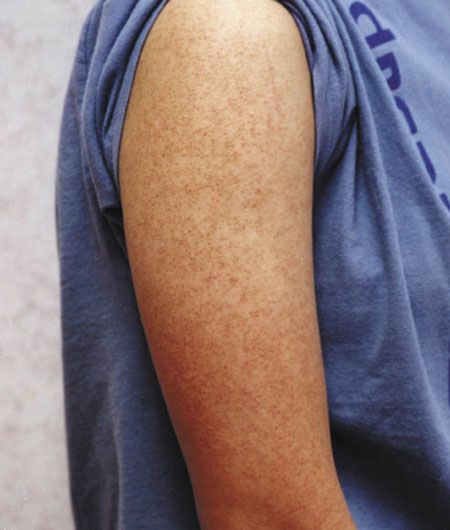Teenager With Small Red Papules on Her Arms and Thighs
17-Year-old girl with a 7-month history of small, red papules on her arms and thighs. Rash is not painful or itchy. Otherwise in good health.
HISTORY
17-Year-old girl with a 7-month history of small, red papules on her arms and thighs. Rash is not painful or itchy. Otherwise in good health.
PHYSICAL EXAMINATION
Numerous, red, cone-shaped follicular papules with keratotic plugs noted on her arms and thighs. Physical examination results otherwise unremarkable.

What’s Your Diagnosis?
Answer and discussion on next page.

Keratosis pilaris is a disorder of keratinization of the infundibulum of pilosebaceous follicles that results in horny plugs that fill the follicular orifice.1
PREVALENCE
Keratosis pilaris is a very common disorder: 40% of the population is affected.2 It develops during childhood and reaches its peak during adolescence. The prevalence in adolescents of both sexes is estimated to be at least 50%, while up to 80% of adolescent girls may be affected.2,3 The disorder involutes spontaneously and is less common during adult life.1,2 There is no racial predominance.4,5
ETIOLOGY
The exact cause is not known. An autosomal dominant mode of inheritance with incomplete penetrance has been postulated.2,3,5 The high prevalence and intensity seen at puberty suggests a hormonal influence. Hyperandrogenism in the presence of obesity is associated with an increased incidence and severity of keratosis pilaris.1
Keratosis pilaris is more common in patients with ichthyosis vulgaris and atopic dermatitis.3 Keratosis pilaris has also been reported to occur as a reaction to contact with cutting oil.6
Other conditions associated with keratosis pilaris include Cushing disease, hypothyroidism, vitamin A intoxication, vitamin C deficiency, monilethrix, Hodgkin disease, monosomy 18p, and cardio-facio-cutaneous syndrome.3,5,7,8 Given the high prevalence of keratosis pilaris, caution is suggested in the interpretation of these associations.3
PATHOLOGY
The follicular orifice is distended by a keratotic plug that may contain twisted hairs.3
CLINICAL MANIFESTATIONS
Keratosis pilaris presents as minute, discrete, keratotic, follicular papules with variable perifollicular erythema.2 The lesions are not grouped and show no tendency to coalesce to form plaques. The affected skin looks like gooseflesh and feels like sandpaper. The lesions are not pruritic. Keratin plugs cannot be expressed with pressure and are usually painless.3,5 The lesions may be isolated or widespread; they have a predilection for the lateral aspects of the upper arms, thighs, and buttocks. The hands and feet are usually spared, but palmoplantar markings are more accentuated.
DIFFERENTIAL DIAGNOSIS
The differential diagnosis includes folliculitis, acne, phrynoderma, pityriasis rubra pilaris, and lichen spinulosus.3 The clinical features of keratosis pilaris are so distinct that usually there is little difficulty in diagnosis.
Treatment Measures should be taken to prevent excessive skin dryness. These include decreasing the frequency of skin cleansing; taking brief, tepid showers rather than long, hot baths; using mild soaps; and humidifying the home.3-5 In mild cases, an emollient-such as hydrophilic petrolatum-or a 10% to 20% urea cream usually alleviates the rough surface. More pronounced or widespread lesions may require treatment with a keratolytic agent, such as lactic acid, salicylic acid, or urea in combination with a topical corticosteroid or retinoic acid.9,10
References:
REFERENCES:
1.
Barth JH, Wojnarowska F, Dawber RP. Is keratosis pilaris another androgen-dependent dermatosis?
Clin Exp Dermatol.
1988;13:240-241.
2.
Poskitt L, Wilkinson JD. Natural history of keratosis pilaris.
Br J Dermatol.
1994;130:711-713.
3.
Lateef A, Schwartz RA, Janniger CK. Keratosis pilaris.
Cutis.
1999;63:205-207.
4.
Novick N. Practical management of widespread, atypical keratosis pilaris.
J Am Acad Dermatol.
1984;11:305-306.
5.
Garwood JD. Keratosis pilaris.
Am Fam Physician.
1978;17:151-152.
6.
Georgouras K. Oil contact keratosis pilaris.
Australas J Dermatol.
1985;26:108-112.
7.
Thomsen K, Nyfors A. Keratosis pilaris: skin marker of Hodgkin disease?
Arch Dermatol.
1973;107:629-630.
8.
Zouboulis CC, Stratakis CA, Rinck G, et al. Ulerythema ophryogenes and keratosis pilaris in a child with monosomy 18p.
Pediatr Dermatol.
1994;11:172-175.
9.
Darmstadt GL. Diseases of the epidermis. In: Behrman RE, Kliegman RM, Jenson HB, eds.
Nelson Textbook of Pediatrics.
Philadelphia: WB Saunders Company; 2000:2001-2006.
10.
Frieden IJ. Other disorders of hair follicles. In: Rudolph AB, Hoffman JI, Rudolph CD, eds.
Rudolph’s Pediatrics.
Stamford, Conn: Appleton & Lange; 1996:926.